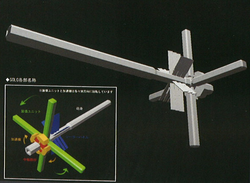- "A military attack satellite that your country began building during the war 15 years ago, then abandoned in the peace that followed."
- ― Major Nastasya Obertas to Albert Genette[1]
The Strategic Orbital Linear Gun[2][3] (戦略衛星軌道砲),[4] often shortened to SOLG, was an orbital weapons platform developed by the Osean Federation. It was designed for use with Kinetic Energy Weapon shells,[4] though any ballistic shell could be loaded onto it.[3]
The SOLG was initially developed to counter Yuktobania during the Cold War. When the Belkan War broke out, Osea prioritized the SOLG's development for use in the war, but it was abandoned after Belka's surrender.[1] The Grey Men later completed the SOLG and equipped it with a V2 warhead during the Circum-Pacific War. It was subsequently destroyed by the Razgriz Squadron.[5]
History
Creation
The SOLG was conceptualized in the early 1990s under Osea's ongoing Strategic Defense Initiative during the Cold War. Yuktobania had developed burst missile technology by this point;[6] consequently, the SOLG was developed to destroy missile silos and act as a deterrent to Osea's enemies, especially Yuktobania.[4]
The SOLG's construction began immediately. However, when Belka declared war on its neighbors in March 1995, including Osea, the SOLG's development became a priority.[1] Yuktobania joined the Allied Forces in the war, leading the SOLG to likely be turned against Belka upon its completion.
However, the SOLG's construction was halted due to the events of June 6, 1995 and Belka's subsequent surrender. Construction was completely canceled following the ratification of the Yuktobanian Peace Treaty in 1996. The satellite was abandoned in geostationary orbit as a result.[4]
Circum-Pacific War
Sometime in late 2010, the SOLG was seized by the Belkan Grey Men, who planned to make use of its offensive capabilities against Osea and Yuktobania. At some point, the Grey Men obtained control of Basset Space Center and began launching cargo shipments to the SOLG. The Belkans completed the long-abandoned satellite, equipped it with KEW shells and a V2 warhead, and constructed a remote control system within Gründer Industries' tunnel network beneath the Waldreich Mountains.[7]
The SOLG's role in the war was eventually discovered by a Yuktobanian reconnaissance officer, Major Nastasya Vasilievna Obertas, who obtained technical data on the SOLG and its V2 arsenal. Nastasya encoded the information on a disk,[1] which she gave to Osean intelligence personnel in the Kestrel Fleet after her escape from Yuktobania.[3]
On December 30, 2010, a coalition force of Osean and Yuktobanian aircraft and ground troops attacked the SOLG control facility in Sudentor, North Osea. The SOLG, which had been hastily completed by the Belkans, opened fire, launching several KEW shells into the mountains north of the industrial sector. Razgriz Squadron, assisted by Captain Jack Bartlett, flew into the massive tunnel and disabled the SOLG's control systems, severing its communication with the surface.[7]
However, the Belkans had planned for this scenario by adding a fail-safe to the SOLG: the satellite's navigational systems began a controlled descent into the atmosphere, placing it on a collision course with the Osean capital of Oured. The SOLG's descent was quickly detected by ground-based observations. In the early morning of December 31, the SOLG descended over Oured Bay on a northwest-southeast heading; it was soon escorted by Ofnir and Grabacr Squadrons. The SOLG was ultimately destroyed after the Razgriz eliminated its core components;[5] the satellite and its V2 warhead were subsequently vaporized in a massive explosion.[8]
Design

The SOLG's design blueprints
As its name suggests, the Strategic Orbital Linear Gun was a maneuverable Kinetic Energy Weapon system designed to fire on surface targets, particularly missile silos, from high orbit altitudes. The SOLG's structure mainly consisted of a long, octagonal gun barrel one kilometer in length.[4]
The SOLG's payload was stored within four large auto-loading magazines, which extended perpendicularly from the back of the gun barrel. These auto-loader units rotated counterclockwise along the barrel's axis; four counterweights on the gun barrel rotated clockwise. Together, the centripetal force generated by this rotational motion (similar to that of a spinning top) likely stabilized the launcher's oblong barrel during firing. This force also worked to accelerate the loaded warhead in the barrel. The SOLG's critical systems were housed in four stationary modules located between the counterweights and auto-loader units. The systems were powered by solar panel arrays affixed to the barrel.[5]
Firing first required the SOLG to receive target coordinates from a ground-based relay station. The SOLG then aimed its gun barrel through unknown means (potentially adjustments in the rotational rate of its counterweights and magazines). Warheads stored vertically within the auto-loader units descended into the firing chamber, where they were accelerated and launched down the barrel towards the target. The warheads would accelerate while descending, gaining enough kinetic energy to cause a massive explosion by the time it hit the target.[3] Since it was designed to destroy missile silos,[4] the explosion likely had a penetration effect as well.
Gallery
The SOLG descending through the atmosphere over Oured Bay
Trivia
- The SOLG is shown to have full long-range firing capabilities when it strikes the ground forces during ACES. However, as a high orbit satellite, the SOLG itself is defenseless at close range.
- This was changed in its Ace Combat Infinity counterpart, which sports multiple defensive TLS turrets along its barrel and ammunition storage units.
References
- ↑ 1.0 1.1 1.2 1.3 Cutscene 23, Ace Combat 5: The Unsung War.
- ↑ Aces At War: A History, page 052.
- ↑ 3.0 3.1 3.2 3.3 Briefing prior to ACES, Ace Combat 5: The Unsung War.
- ↑ 4.0 4.1 4.2 4.3 4.4 4.5 Ace Combat 5: The Unsung War Perfect Guide, page 237.
- ↑ 5.0 5.1 5.2 The Unsung War, Ace Combat 5: The Unsung War.
- ↑ WORLD / WORLD NEWS / ПОСЛЕДУЙТЕ, Ace Combat 5 Website. Retrieved January 9, 2017.
- ↑ 7.0 7.1 ACES, Ace Combat 5: The Unsung War.
- ↑ Cutscene 28, Ace Combat 5: The Unsung War.



